Basin Ecological Zoning Based on Supply–Demand Assessment and Matching of Green Infrastructure: A Case Study of the Jialing River Basin
Abstract
1. Introduction
2. Materials and Methods
2.1. Study Area and Data
2.2. Method
2.2.1. Assessment of GI Supply Capacity
- GI element composition indicators
- 2.
- GI structural configuration indicators
- 3.
- GI ecological services indicators
2.2.2. Assessment of GI Demand Intensity
- Environmental pressure indicators
- 2.
- Urban expansion demand indicators
- 3.
- Social development needs indicators
2.2.3. GI Supply–Demand Matching and Coupling Coordination Degree
3. Results
3.1. Evaluation Results of GI Supply Level Index in Counties of the Jialing Basin
3.2. Evaluation Results of GI Demand Level Index in Counties of the Jialing Basin
3.3. Analysis of Coupling Coordination Degree of GI Supply and Demand Matching Level in Basin Counties
- Supply-Deficit Type: This category included upstream counties such as Liangdang, Xihe, and Chengxian, as well as midstream and downstream counties like Langzhong, Shunqing, and Beibei. These areas exhibited high urbanization levels and advanced economic development but suffered from inadequate GI quality, making it challenging to meet ecological demand. These regions were identified as priority areas for urgent GI optimization and enhancement.
- Supply-Surplus Type: This type was primarily distributed in the upper reaches of the Jialing River Basin, including counties such as Fengxian and Qingchuan. These areas exhibited relatively low urban development levels but high GI quality, making them critical regions for ecological conservation and GI preservation.
- High-Level Balanced Type: This type was concentrated around Guangyuan City in Sichuan Province, where the GI supply–demand relationship was relatively stable. However, ecological performance needed further improvement to sustain long-term environmental stability.
- Low-Level Balanced Type: This type was mainly distributed in the agricultural production areas of the middle reaches of the basin. These counties demonstrated moderate GI supply and demand levels, requiring enhanced GI supply to address future socio-economic and environmental demands.
4. Discussion: Determination of GI Optimization Zoning and Formulation of Improvement Strategies in the Jialing River Basin
4.1. Key GI Network Restoration Area
4.2. Key GI Network Management Zones
4.3. Key GI Network Rehabilitation Zones
4.4. Key GI Network Enhancement Zones
4.5. Key GI Network Conservation Zones
5. Conclusions and Prospect
Author Contributions
Funding
Data Availability Statement
Acknowledgments
Conflicts of Interest
Abbreviations
| GI | Green Infrastructure |
| MSPA | Morphological Spatial Pattern Analysis |
| In-VEST | Integrated Valuation of Ecosystem Services and Tradeoffs |
References
- Restrepo, J.D.; Bottaro, G.; Barci, L.; Beltrán, L.M.; Londoño-Behaine, M.; Masiero, M. Assessing the Impacts of Nature-Based Solutions on Ecosystem Services: A Water-Energy-Food-Ecosystems Nexus Approach in the Nima River Sub-Basin (Colombia). Forests 2024, 15, 1852. [Google Scholar] [CrossRef]
- Costanza, R.; De Groot, R.; Braat, L.; Kubiszewski, I.; Fioramonti, L.; Sutton, P.; Farber, S.; Grasso, M. Twenty years of ecosystem services: How far have we come and how far do we still need to go? Ecosyst. Serv. 2017, 28, 1–16. [Google Scholar]
- Li, M.; Xu, N.; Liu, F.; Tong, H.; Ding, N.; Dong, J.; Wang, M. Ecological Management Zoning Based on the Supply–Demand Relationship and Synergies of Urban Forest Ecosystem Services: A Case Study from Fuzhou, China. Forests 2025, 16, 17. [Google Scholar]
- Roces-Diaz, J.V.; Vayreda, J.; Banque-Casanovas, M.; Diaz-Varela, E.; Bonet, J.A.; Brotons, L.; de-Miguel, S.; Herrando, S.; Martinez-Vilalta, J. The spatial level of analysis affects the patterns of forest ecosystem services supply and their relationships. Sci. Total Environ. 2018, 626, 1270. [Google Scholar]
- Yue, W.Z.; Hou, L.; Xia, H.X.; Wei, J.X.; Lu, Y.P. Territorially ecological restoration zoning and optimization strategy in Guyuan City of Ningxia, China: Based on the balance of ecosystem service supply and demand. Chin. J. Appl. Ecol. 2022, 33, 149–158. [Google Scholar]
- Dong, X.Y.; Yi, W.X.; Yuan, P.; Song, Y.H. Optimization and trade-off framework for coupled green-grey infrastructure considering environmental performance. J. Environ. Manag. 2023, 329, 117041. [Google Scholar] [CrossRef]
- Islam, M.R.; Shahfahad Talukdar, S.; Rihan, M.; Rahman, A. Evaluating cooling effect of blue-green infrastructure on urban thermal environment in a metropolitan city: Using geospatial and machine learning techniques. Sustain. Cities Soc. 2024, 113, 105666. [Google Scholar] [CrossRef]
- Wu, H.W.; Kumar, P.; Cao, S.J. The role of roadside green infrastructure in improving air quality in and around elderly care centres in Nanjing, China. Atmos. Environ. 2024, 332, 120607. [Google Scholar] [CrossRef]
- Wang, Z.; Li, Z.; Wang, Y.; Zheng, X.; Deng, X. Building green infrastructure for mitigating urban flood risk in Beijing, China. Urban For. Urban Green. 2024, 93, 128218. [Google Scholar] [CrossRef]
- Chen, Y.; Wang, Y.; Liew, J.H.; Wang, P.L. Development of a methodological framework for evaluating biodiversity of built urban green infrastructures by practitioners. J. Clean. Prod. 2021, 303, 127009. [Google Scholar] [CrossRef]
- Kavehei, E.; Jenkins, G.A.; Adame, M.F.; Lemckert, C. Carbon sequestration potential for mitigating the carbon footprint of green stormwater infrastructure. Renew. Sustain. Energy Rev. 2018, 94, 1179–1191. [Google Scholar] [CrossRef]
- Shou, T.; Li, K.; Li, Y.; Ni, Y.; Lu, D.; Wei, J. How do contextual factors mediate and moderate the association between green infrastructure and respiratory health? A systematic review and meta-analysis. Urban For. Urban Green. 2024, 98, 128392. [Google Scholar] [CrossRef]
- Dipeolu, A.A.; Ibem, E.O.; Fadamiro, J.A. Influence of green infrastructure on sense of community in residents of Lagos Metropolis, Nigeria. J. Hum. Behav. Soc. Environ. 2020, 30, 743–759. [Google Scholar] [CrossRef]
- Lina, F.; Lorenza, N.; Fausto, M.; Alessandro, S.; Silvano, F. Supply and demand mismatch analysis to improve regulating ecosystem services in Mediterranean urban areas: Insights from four Italian Municipalities. Ecol. Indic. 2023, 155, 110928. [Google Scholar]
- Dobbs, C.; Kendal, D.; Nitschke, C.R. Multiple ecosystem services and disservices of the urban forest establishing their connections with landscape structure and sociodemographics. Ecol. Indic. 2014, 43, 44–55. [Google Scholar] [CrossRef]
- Grafius, D.R.; Corstanje, R.; Harris, J.A. Linking ecosystem services, urban form and green space configuration using multivariate landscape metric analysis. Landsc. Ecol. 2018, 33, 557–573. [Google Scholar] [CrossRef] [PubMed]
- Uuemaa, E.; Mander, Ü.; Marja, R. Trends in the use of landscape spatial metrics as landscape indicators: A review. Ecol. Indic. 2013, 28, 100–106. [Google Scholar] [CrossRef]
- Ojoyi, M.M.; Odindi, J.; Mutanga, O.; Abdel-Rahman, E.M. Analysing fragmentation in vulnerable biodiversity hotspots in Tanzania from 1975 to 2012 using remote sensing and fragstats. Nat. Conserv. 2016, 16, 19–37. [Google Scholar]
- Frazier, A.E.; Kedron, P. Landscape metrics: Past progress and future directions. Curr. Landsc. Ecol. Rep. 2017, 2, 63–72. [Google Scholar] [CrossRef]
- Nasehi, S.; Imanpour namin, A. Assessment of urban green space fragmentation using landscape metrics (case study: District 2, Tehran city). Model. Earth Syst. Environ. 2020, 6, 2405–2414. [Google Scholar] [CrossRef]
- Peng, J.; Yang, Y.; Xie, P.; Liu, Y.X. Zoning for the construction of green space ecological networks in Guangdong Province based on the supply and demand of ecosystem services. Acta Ecol. Sin. 2017, 37, 4562–4572. [Google Scholar]
- Liu, B.; Tian, Y.; Guo, M.; Tran, D.; Alwah, A.A.Q.; Xu, D. Evaluating the disparity between supply and demand of park green space using a multi-dimensional spatial equity evaluation framework. Cities 2021, 121, 103484. [Google Scholar]
- Rahman, K.M.A.; Zhang, D. Analyzing the level of accessibility of public urban green spaces to different socially vulnerable groups of people. Sustainability 2018, 10, 3917. [Google Scholar] [CrossRef]
- Zhou, Y.; Wu, X. Identification of priority areas for green stormwater infrastructure based on supply and demand evaluation of flood regulation service. Environ. Dev. 2023, 45, 100815. [Google Scholar]
- de Manuel, B.; FernandezMendez-Fernandez, L.; Pena, L.; Ametzaga-Arregi, I. A new indicator of the effectiveness of urban green infrastructure based on ecosystem services assessment. Basic Appl. Ecol. 2021, 53, 12–25. [Google Scholar] [CrossRef]
- Lin, Y.; Zhang, M.; Gan, M.; Huang, L.; Zhu, C.; Zheng, Q.; You, S.; Ye, Z.; Shahtahmassebi, A.; Li, Y.; et al. Fine identification of the supply–demand mismatches and matches of urban green space ecosystem services with a spatial filtering tool. J. Clean. Prod. 2022, 336, 130404. [Google Scholar]
- Li, M.H.; Wang, G.Y.; Li, H.Y.; Chen, T.; Tang, S. Identifying the optimization potential for urban GI by linking supply and demand of ecosystem services under multi-scenarios: A case study of Tianjin, China. Ecol. Indic. 2023, 154, 110570. [Google Scholar]
- Zhao, H.X.; Gu, B.J.; Wang, J.Q.; Fan, J.D.; Li, X. Characteristics of green infrastructure supply-demand adaptation relationship and its pattern in Nanjing City. Acta Ecol. Sin. 2024, 44, 463–475. [Google Scholar]
- Luo, C.; Yu, H.; Liu, Y.; Yang, W. Supply and demand assessment of physical activity services provided by urban green spaces: A case study of Chongqing, China. Urban For. Urban Green. 2024, 95, 128315. [Google Scholar]
- Xiao, H.B.; Sheng, S.; An, Q. Research on the Identification of Urban Green Infrastructure Supply-Demand Spatial Differentiation and Optimization Strategies: A Case Study on Jinan West New District. Chin. Landsc. Archit. 2019, 35, 65–69. [Google Scholar]
- Hegetschweiler, K.T.; de Vries, S.; Arnberger, A.; Bell, S.; Brennan, M.; Siter, N.; Olafsson, A.S.; Voigt, A.; Hunziker, M. Linking demand and supply factors in identifying cultural ecosystem services of urban green infrastructures: A review of European studies. Urban For. Urban Green. 2017, 21, 48–59. [Google Scholar]
- Ying, J.; Zhang, X.J.; Zhang, Y.Q.; Bilan, S. Green infrastructure: Systematic literature review. Econ. Res. Ekon. Istraživanja 2022, 35, 343–366. [Google Scholar]
- Luo, C.; Wang, F.M.; Li, G.G.; Yang, C.X. Identifying supply-demand spatial matches of cultural ecosystem services provided by urban parks in polycentric mountainous cities. Acta Ecol. Sin. 2024, 44, 5816–5827. [Google Scholar]
- Zhang, J.; Tan, P.Y. Assessment of spatial equity of urban park distribution from the perspective of supply-demand interactions. Urban For. Urban Green. 2023, 80, 127827. [Google Scholar]
- Burkhard, B.; Kandziora, M.; Hou, Y.; Müller, F. Ecosystem service potentials, flows and demands-concepts for spatial localisation, indication and quantification. Landsc. Online 2014, 34, 1–32. [Google Scholar] [CrossRef]
- Baró, F.; Palomo, I.; Zulian, G.; Vizcaino, P.; Haase, D.; Gómez-Baggethun, E. Mapping ecosystem service capacity, flow and demand for landscape and urban planning: A case study in the Barcelona metropolitan region. Land Use Policy 2016, 57, 405–417. [Google Scholar]
- Chen, J.; Jiang, B.; Bai, Y.; Xu, X.; Alatalo, J.M. Quantifying ecosystem services supply and demand shortfalls and mismatches for management optimisation. Sci. Total Environ. 2019, 650, 1426–1439. [Google Scholar]
- Chen, W.; Liu, H.; Wang, J. Construction and optimization of regional ecological security patterns based on MSPA-MCR-GA Model: A case study of Dongting Lake Basin in China. Ecol. Indic. 2024, 165, 112169. [Google Scholar]
- Wang, F.; Liu, Y.; He, J.S.; Hu, X.; Qin, Y.; Wang, L.Y. River basin habitats science: Framework and prospects. J. Nat. Resour. 2024, 39, 997–1007. [Google Scholar]
- Zhang, S.; Liu, Y.; Wang, T. How land use change contributes to reducing soil erosion in the Jialing River Basin, China. Agric. Water Manag. 2014, 133, 65–73. [Google Scholar]
- Wang, Y.H.; Li, C.L.; Wang, H.; Liang, B.M.; Lv, J.S. Research status and hot topics in the field of ecological environment of green infrastructure. Acta Ecol. Sin. 2022, 42, 2510–2521. [Google Scholar]
- Guo, W.; Jiao, X.; Zhou, H.; Zhu, Y.; Wang, H. Hydrologic regime alteration and influence factors in the Jialing River of the Yangtze River, China. Sci. Rep. 2022, 12, 11166. [Google Scholar]
- Liu, L.Y.; Bian, Z.Q.; Ding, S.Y. Effects of landscape spatial heterogeneity on the generation and provision of ecosystem services. Acta Ecol. Sin. 2018, 38, 6412–6421. [Google Scholar]
- Liu, Y.N.; Kong, L.Q.; Xiao, Y.; Zheng, H. Relationships between landscape pattern and ecosystem water purification service in the Yangtze River Basin. Acta Ecol. Sin. 2019, 39, 844–852. [Google Scholar]
- Wickham, J.D.; Riitters, K.H.; Wade, T.G.; Vogt, P. A national assessment of green infrastructure and change for the conterminous United States using morphological image processing. Landsc. Urban Plan. 2010, 94, 186–195. [Google Scholar]
- Soille, P.; Vogt, P. Morphological segmentation of binary patterns. Pattern Recognit. Lett. 2009, 30, 456–459. [Google Scholar]
- Wu, Z.; Zhang, S.; Liu, M.; Wu, Z.; Hu, X.; Lin, S. Impact of Forest Landscape Patterns on Ecological Quality in Coastal Cities of Fujian, China, from 2000 to 2020. Forests 2024, 15, 1925. [Google Scholar] [CrossRef]
- Wu, Z.F.; Hu, W.P.; Chen, J. Landscape ecological cluster analysis of typical area in Zhujiang Delta. Ecol. Environ. 2005, 14, 63–66. [Google Scholar]
- Xiang, Q.; Kan, A.; Yu, X.; Liu, F.; Huang, H.; Li, W.; Gao, R. Assessment of Topographic Effect on Habitat Quality in Mountainous Area Using InVEST Model. Land 2023, 12, 186. [Google Scholar] [CrossRef]
- Zhang, X.; Zhang, G.; Long, X.; Zhang, Q.; Liu, D.; Wu, H.; Li, S. Identifying the drivers of water yield ecosystem service: A case study in the Yangtze River Basin, China. Ecol. Indic. 2021, 132, 108304. [Google Scholar]
- Zhao, H.; Guo, B.; Wang, G. Spatial–Temporal Changes and Prediction of Carbon Storage in the Tibetan Plateau Based on PLUS-InVEST Model. Forests 2023, 14, 1352. [Google Scholar] [CrossRef]
- Xiao, Q.; Hu, D.; Xiao, Y. Assessing changes in soil conservation ecosystem services and causal factors in the Three Gorges Reservoir region of China. J. Clean. Prod. 2017, 163, S172–S180. [Google Scholar] [CrossRef]
- Peña, L.; Casado-Arzuaga, I.; Onaindia, M. Mapping recreation supply and demand using an ecological and a social evaluation approach. Ecosyst. Serv. 2015, 13, 108–118. [Google Scholar] [CrossRef]
- Zhu, W.; Huang, J.; Yang, S.; Liu, W.; Dai, Y.; Huang, G.; Lin, J. Spatiotemporal Evolution, Driving Mechanisms, and Zoning Optimization Pathways of Ecosystem Health in China. Forests 2024, 15, 1987. [Google Scholar] [CrossRef]
- Wang, J.Y.; Zhai, Z.Q.; Guo, G.Q.; Tao, T.Y. Study on water environmental carrying capacity evaluation in Taihu Lake Basin. China Environ. Sci. 2017, 5, 1979–1987. [Google Scholar]
- Lai, J.; Li, J.; Liu, L. Predicting Soil Erosion Using RUSLE and GeoSOS-FLUS Models: A Case Study in Kunming, China. Forests 2024, 15, 1039. [Google Scholar] [CrossRef]
- Liu, Y.; Wang, J.; Deng, X. Rocky land desertification and its driving forces in the karst areas of rural Guangxi, Southwest China. J. Mt. Sci. 2008, 5, 350–357. [Google Scholar] [CrossRef]
- Elmqvist, T.; Fragkias, M.; Goodness, J.; Güneralp, B.; Marcotullio, P.J.; McDonald, R.I.; Parnell, S.; Schewenius, M.; Sendstad, M.; Seto, K.C.; et al. Urbanization, Biodiversity and Ecosystem Services: Challenges and Opportunities: A Global Assessment; Springer Nature: Berlin/Heidelberg, Germany, 2013. [Google Scholar]
- McPhearson, T.; Hamstead, Z.A.; Kremer, P. Urban ecosystem services for resilience planning and management in New York City. Ambio 2014, 43, 502–515. [Google Scholar] [CrossRef]
- Mazziotta, M.; Pareto, A. Normalization methods for spatio-temporal analysis of environmental performance: Revisiting the Min–Max method. Environmetrics 2022, 33, e2730. [Google Scholar]
- Elliott, R.M.; Motzny, A.E.; Majd, S.; Chavez, F.J.; Laimer, D.; Orlove, B.S.; Culligan, P.J. Identifying linkages between urban green infrastructure and ecosystem services using an expert opinion methodology. Ambio 2020, 49, 569–583. [Google Scholar] [CrossRef]
- 62. Malekinezhad, H.; Sepehri, M.; Pham, Q.B.; Hosseini, S.Z.; Meshram, S.G.; Vojtek, M.; Vojteková, J. Application of entropy weighting method for urban flood hazard mapping. Acta Geophys. 2021, 69, 841–854. [Google Scholar] [CrossRef]
- Sun, Y.; Liu, S.; Shi, F.; An, Y.; Li, M.; Liu, Y. Spatio-temporal variations and coupling of human activity intensity and ecosystem services based on the four-quadrant model on the Qinghai-Tibet Plateau. Sci. Total Environ. 2020, 743, 140721. [Google Scholar]
- Aghajani, H.; Sarkari, F.; Borhani, M. Coupling coordination analysis between urbanization and ecology in Iran. Front. Urban Rural Plan. 2024, 2, 5. [Google Scholar]
- Feng, M.; Zhao, W.; Zhang, T. Construction and Optimization Strategy of County Ecological Infrastructure Network Based on MCR and Gravity Model—A Case Study of Langzhong County in Sichuan Province. Sustainability 2023, 15, 8478. [Google Scholar] [CrossRef]
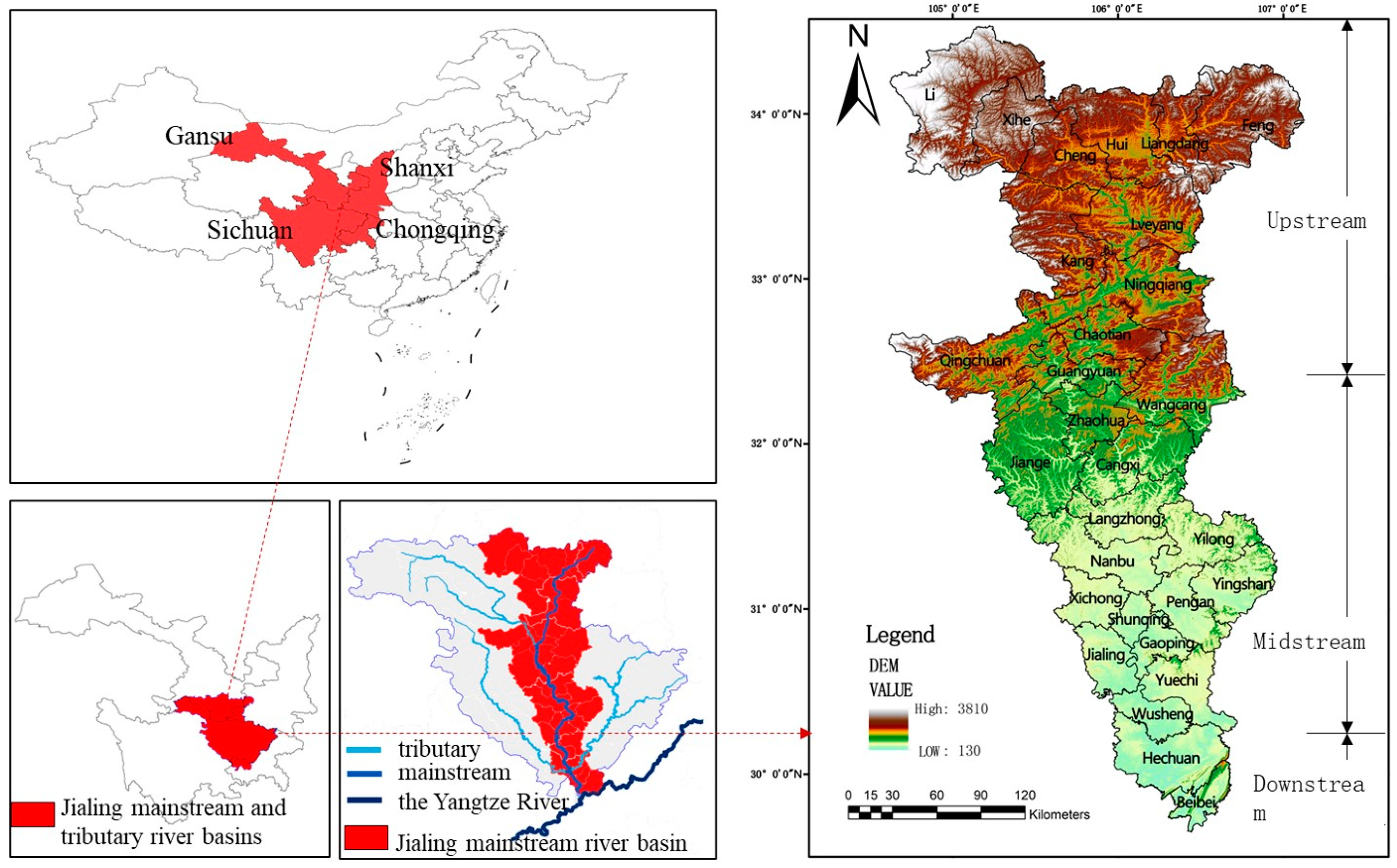
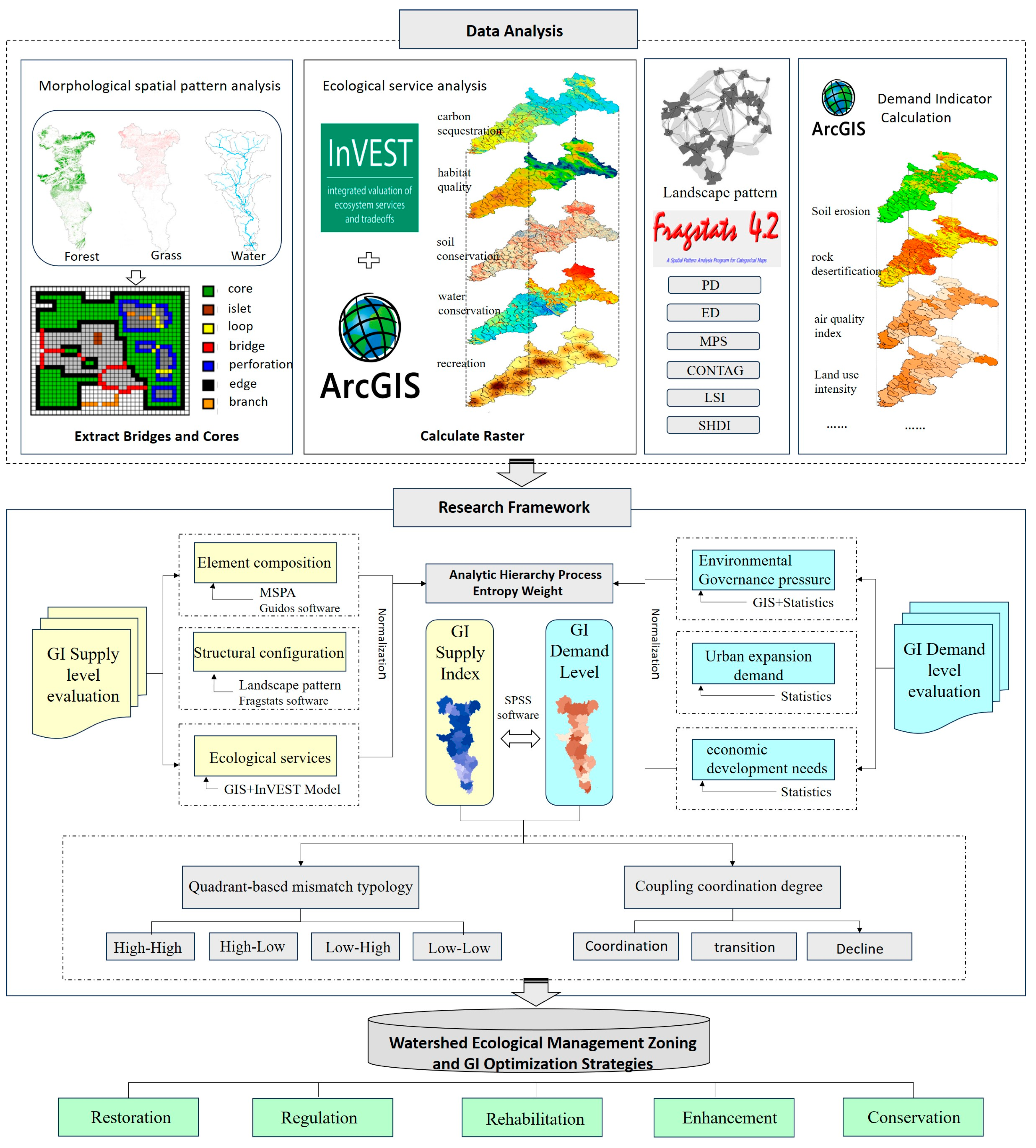


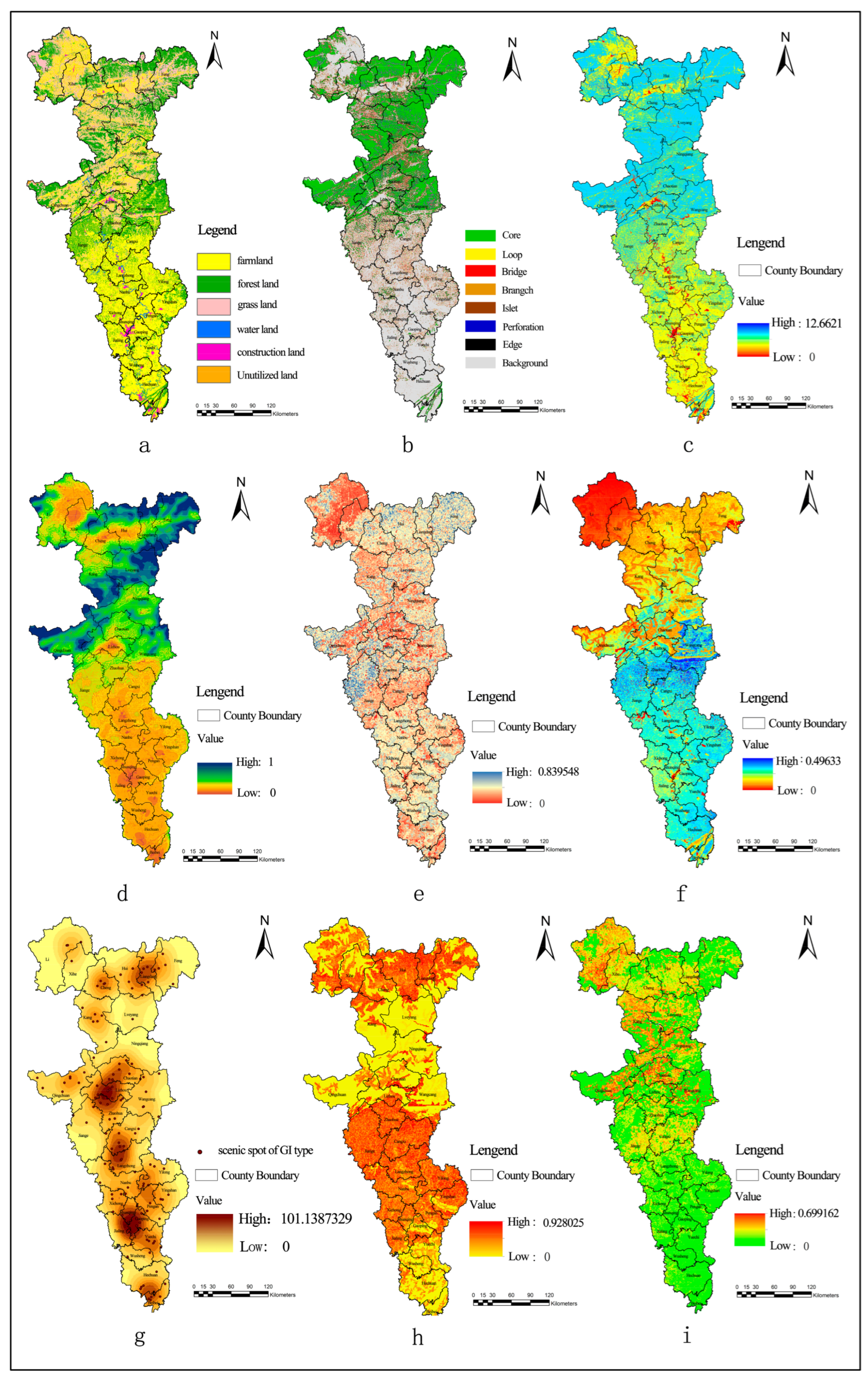

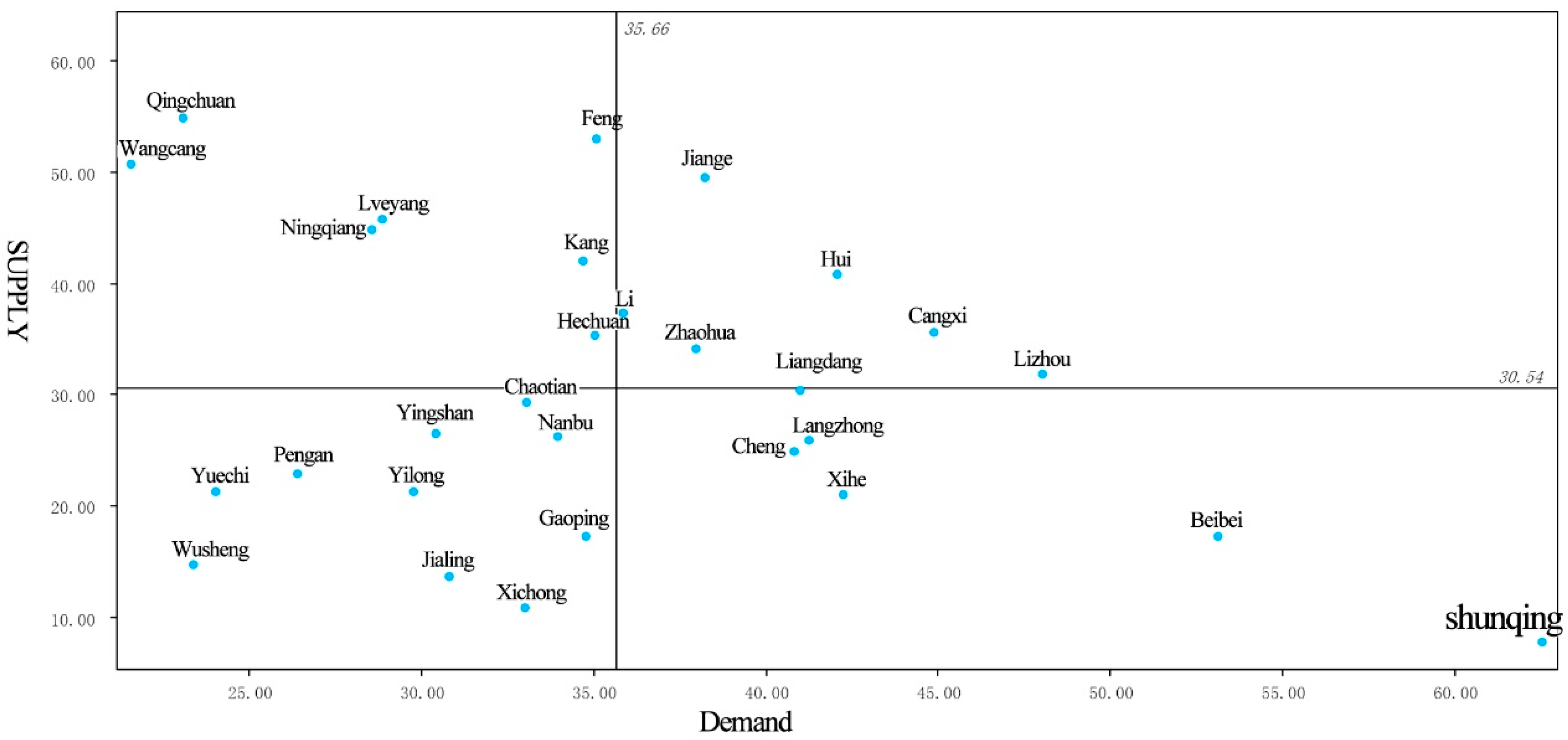

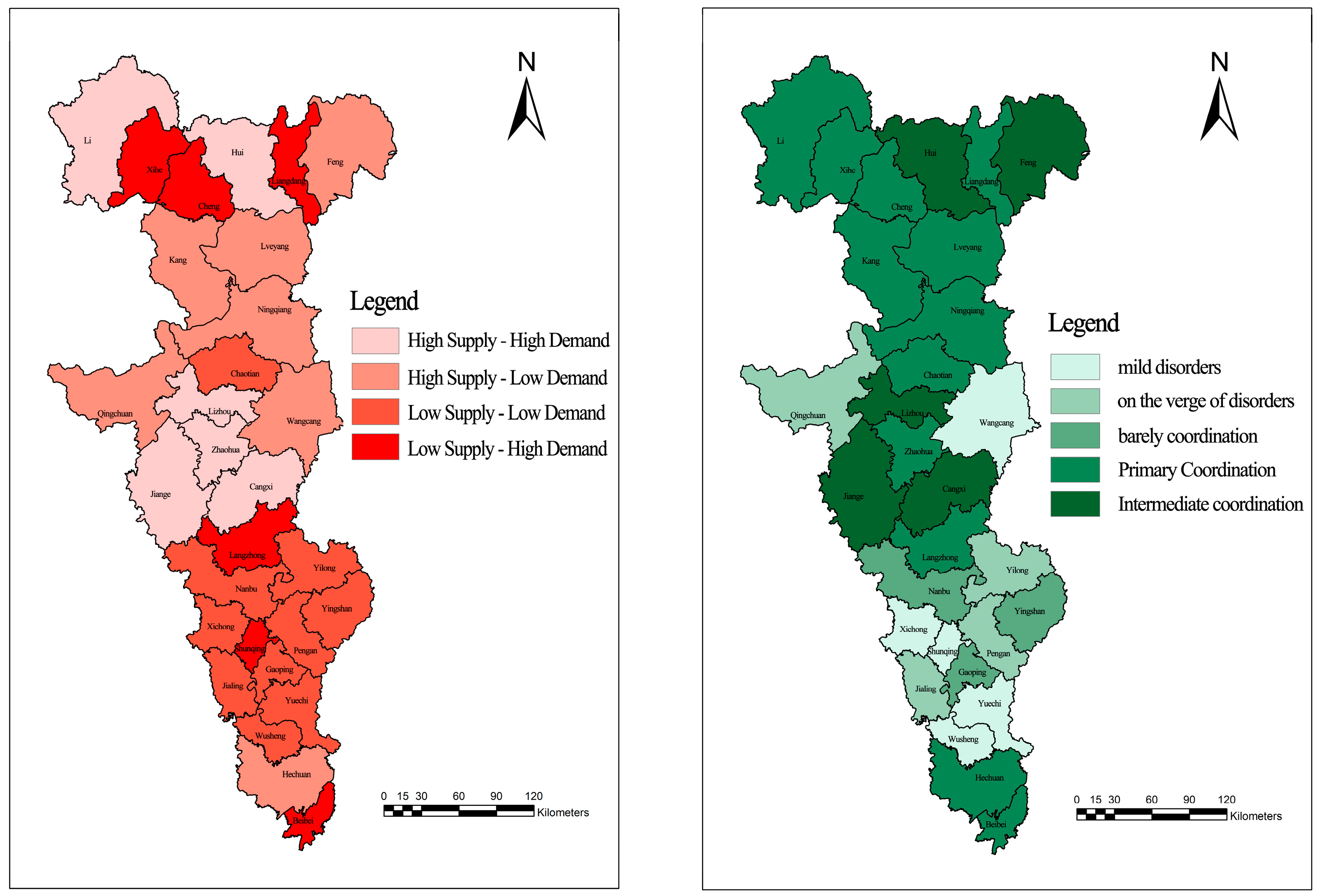
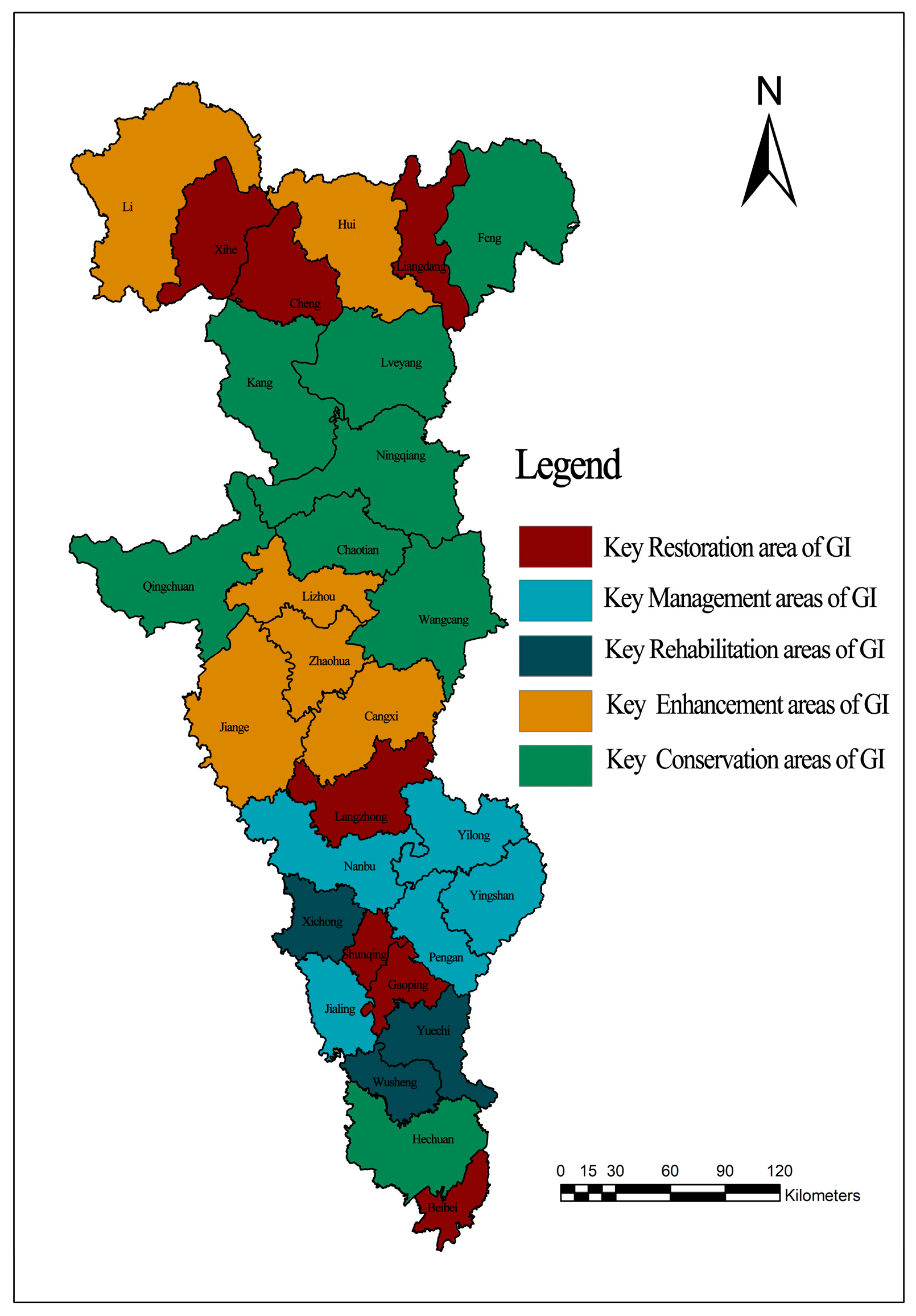
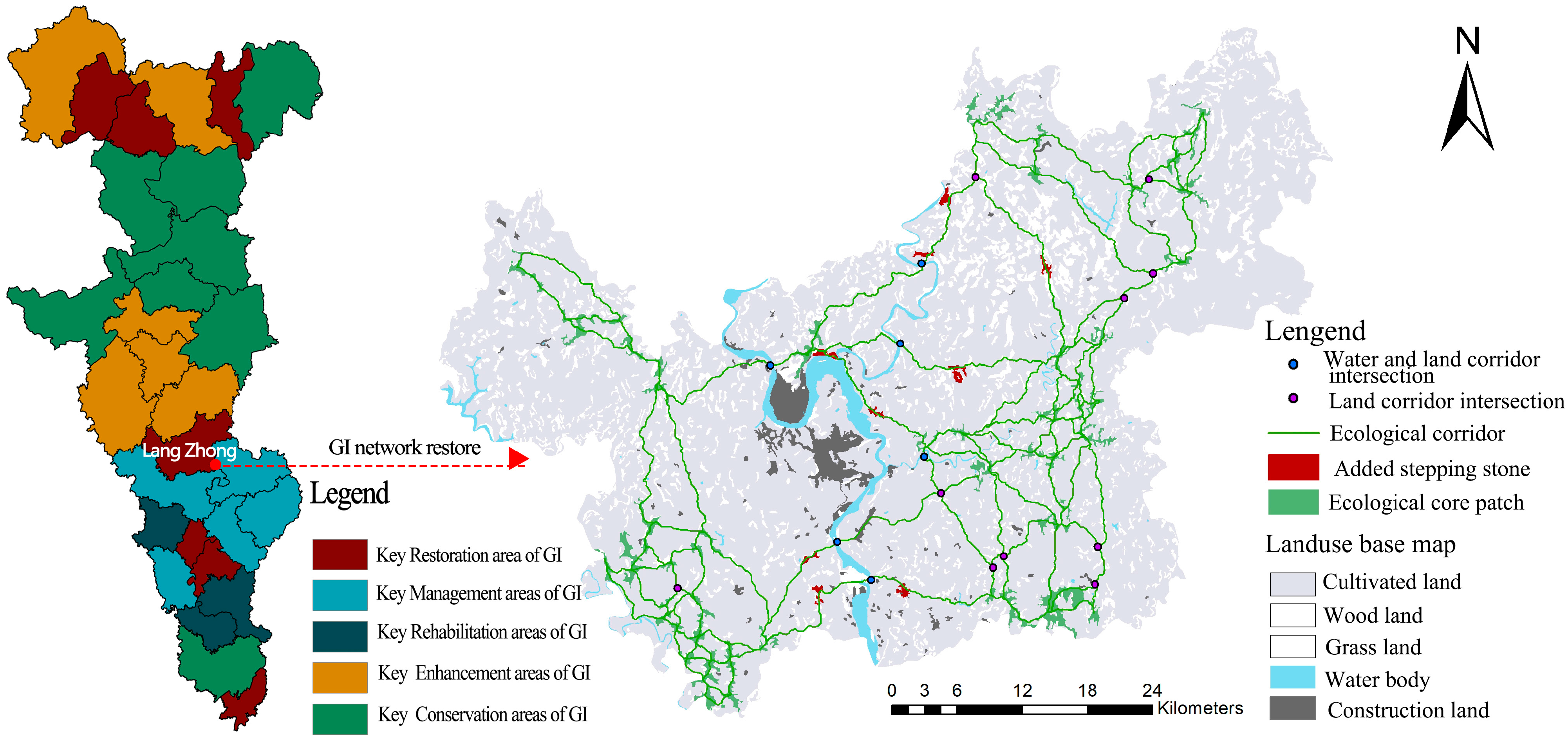
| Data Usage | Name | Year | Resolution | Source |
|---|---|---|---|---|
| Basic Data | Administrative boundaries data | 2023 | - | Geospatial Data Cloud (http://www.gscloud.cn/) |
| Assessing factor composition and structural configuration indicators of GI supply | Land-use data | 2020 | 30 m | Resource and environmental science data platform (https://www.resdc.cn/data.aspx) |
| Assessing ecological services of GI supply level and environmental governance pressure of GI demand level | The digital elevation model (DEM) | 2023 | 30 m | Geospatial Data Cloud (http://www.gscloud.cn) |
| Meteorological data | 2023 | - | China Meteorological Science Data Sharing Service Network (http://data.cma.cn/) | |
| The multi-year average net primary productivity | 2015–2022 | 30 m | MODIS 17A3 remote sensing data available on the NASA website (https://ladsweb.modaps.eosdis.nasa.gov/) | |
| Soil Data | 2020 | 1 km | Resource and environmental science data platform (https://www.resdc.cn/data.aspx) | |
| Normalized Difference Vegetation Index | 2023 | 30 m | National Science & Technology Infrastructure (https://www.nesdc.org.cn/) | |
| Point of recreational resources data | 2023 | - | Baidu Maps Open Platform (https://lbsyun.baidu.com/) | |
| Average Air Quality Index | 2023 | - | China Air Quality website (https://www.iqair.cn/cn/china, accessed on 31 January 2025) | |
| Assessing urban expansion demand and social development needs of GI demand level | Population data | 2023 | - | The statistical yearbooks (obtained from the government) |
| Social and Economic Data | 2023 | - | statistical bulletins on national economic and social development (obtained from the government) |
| Function | GI Function Utilization | Formula |
|---|---|---|
| wate yield | Mainly considering factors such as river source area, river water supply function, surface coverage, terrain, etc. | WR = NPPmean × Fsic × Fpre × (1 − Fsol) Indicator explanation: NPPmean is the average net primary productivity of vegetation over the years, Fsic is the soil infiltration factor, Fbre is the average precipitation factor over the years, and Fslo is the slope factor |
| soil conservation | GI reduces soil erosion caused by water erosion through its structure and processes | SC = NPPmean × (1 − K) × (1 − Fsol) Indicator explanation: NPPmean is the average net primary productivity of vegetation over many years, Fslo is the slope factor, and K is the soil erodibility factor. |
| habitat quality | GI can provide habitats for organisms, which characterizes the degree of excellence of their living environment, and is evaluated using the INVEST model | Qxj = Hj × [1 − Dxjz/(Dxjz + kz)] Explanation of indicators: Hj is the habitat suitability, k is the semi saturation constant, generally half of the maximum degree of habitat degradation is taken, z is the normalization constant, and parameter selection refers to existing research in neighboring areas. |
| carbon sequestration | GI captures and fixes CO2 in the atmosphere through photosynthesis, effectively regulates it, and evaluates it using the Carbon Storage module in the INVEST model | Ctot = Cabove + Cbelow + Csoil + Cdead Indicator explanation: Ctot represents total carbon storage, Cabove represents aboveground biochar, Cbelow represents underground biochar, Csoil represents soil organic carbon, and Cdead represents dead organic matter. |
| recreation | Related to the density of GI recreational resources (parks, scenic spots, etc.) | CR = NDpoi Indicator explanation: NDpoi is the core density value of GI recreational resources |
| Target Layer | First Level Indicator | Secondary Level Indicator | Indicator Direct-Ion | Indicator Explanation/Calculation Method | Weight |
|---|---|---|---|---|---|
| GI supply Level index of each county in the Jialing River Basin | factor composition | Proportion of GI to total land use | + | Ratio of forest, grass and water to total land use | 0.0124 |
| Proportion of forest to GI | + | The ratio of forest land to the total land use in GI | 0.0542 | ||
| Proportion of water area to GI | + | Ratio of water area to total land use in GI | 0.0522 | ||
| Proportion of ecological core to GI | + | Using forests, grass, and water as foreground and others as background, using Guidos Toolbox 2.8 with an edge width set to 30 m, the binary raster data of land use is segmented to identify the core | 0.0715 | ||
| Proportion of connection bridge to GI | + | Using forests, grass, and water as foreground and others as background, using Guidos Toolbox software with an edge width set to 30 m, the binary raster data of land use is segmented to identify the bridge | 0.0547 | ||
| structural configuration | Mean plaque area (MPS) | + | The average area of GI plaques, the higher the value, the lower the degree of fragmentation (calculated by Fragstats) | 0.0574 | |
| Plaque density (PD) | − | The ratio of the total number of GI plaques to the total area, with higher values indicating higher fragmentation and heterogeneity (Fragstats) | 0.036 | ||
| Edge density (ED) | − | The higher the value, the higher the heterogeneity of GI landscape (Fragstats) | 0.0644 | ||
| Spread Index (CONTAG) | + | Describing the degree of aggregation of different types of GI plaques, with higher values indicating greater aggregation (Fragstats) | 0.0529 | ||
| Landscape Shape Index (LSI) | + | The higher the value, the more irregular the shape of GI patches and the stronger the ecological edge effect (Fragstats) | 0.0977 | ||
| Fragrant Diversity Index (SHDI) | + | The higher the value, the more balanced the distribution of GI patches at the landscape level, and the lower the heterogeneity (Fragstats) | 0.0629 | ||
| Ecological services | Wate yield | + | The total value of grid wate yield function within the county scale | 0.0781 | |
| Soil Conservation | + | The total sum of grid soil conservation function values within the county scale | 0.0731 | ||
| Habitat quality | + | The total value of grid biodiversity conservation function at the county scale | 0.1211 | ||
| Carbon sequestration | + | The total value of grid carbon sequestration function within the county scale | 0.0784 | ||
| Recreation | + | The sum of grid recreational function values within the county scale | 0.0334 |
| Target Layer | First Level Indicator | Secondary Level Indicator | Indicator Direction | Indicator Explanation/Calculation Method | Weight |
|---|---|---|---|---|---|
| GI demand level index of each county in the Jialing River Basin | Environmental governance pressure | Soil erosion intensity | + | The demand for soil erosion control is calculated based on the proportion of areas with extremely high soil erosion and high sensitivity | 0.224 |
| Rock desertification intensity | + | The demand for restoration of rocky desertification is calculated based on the proportion of areas with extremely high and highly sensitive rocky desertification | 0.151 | ||
| Annual average air quality index | + | National Meteorological Statistics Data | 0.048 | ||
| Urban expansion demand | Land use intensity | + | The ratio of construction land to total land use | 0.118 | |
| Population density | + | Directly obtain statistical yearbooks | 0.146 | ||
| Social development needs | Per capita GDP | + | Directly obtain statistical yearbooks | 0.085 | |
| The proportion of tertiary industry | + | Directly obtain statistical yearbooks | 0.117 | ||
| Urbanization rate | + | Directly obtain statistical yearbooks | 0.224 |
| Supply and Demand Analysis | Type/Degree | Classification Basis | Quantity (Piece) | Proportion of Area |
|---|---|---|---|---|
| the quadrant matching analysis | High-level balanced type (High Supply–High Demand) | first quadrant | 6 | 26.48% |
| Supply-Surplus Type (High Supply–Low Demand) | Beta Quadrant | 7 | 35.45% | |
| Low-level balanced type (Low Supply–Low Demand) | third quadrant | 10 | 24.15% | |
| Supply-Deficit Type (Low Supply–High Demand) | Delta Quadrant | 6 | 13.92% | |
| coupling coordination analysis | Imbalance type | [0.3–0.4) | 5 | 12.12% |
| Transitional type | [0.4–0.5) | 4 | 12.85% | |
| [0.5–0.6) | 3 | 7.98% | ||
| Coordinated type | [0.6–0.7) | 12 | 44.95% | |
| [0.7–0.8) | 5 | 22.10% |
Disclaimer/Publisher’s Note: The statements, opinions and data contained in all publications are solely those of the individual author(s) and contributor(s) and not of MDPI and/or the editor(s). MDPI and/or the editor(s) disclaim responsibility for any injury to people or property resulting from any ideas, methods, instructions or products referred to in the content. |
© 2025 by the authors. Licensee MDPI, Basel, Switzerland. This article is an open access article distributed under the terms and conditions of the Creative Commons Attribution (CC BY) license (https://creativecommons.org/licenses/by/4.0/).
Share and Cite
Feng, M.; Li, Y.; Xu, L.; Zhang, T. Basin Ecological Zoning Based on Supply–Demand Assessment and Matching of Green Infrastructure: A Case Study of the Jialing River Basin. Forests 2025, 16, 561. https://doi.org/10.3390/f16040561
Feng M, Li Y, Xu L, Zhang T. Basin Ecological Zoning Based on Supply–Demand Assessment and Matching of Green Infrastructure: A Case Study of the Jialing River Basin. Forests. 2025; 16(4):561. https://doi.org/10.3390/f16040561
Chicago/Turabian StyleFeng, Mao, Yunyan Li, Lihua Xu, and Tao Zhang. 2025. "Basin Ecological Zoning Based on Supply–Demand Assessment and Matching of Green Infrastructure: A Case Study of the Jialing River Basin" Forests 16, no. 4: 561. https://doi.org/10.3390/f16040561
APA StyleFeng, M., Li, Y., Xu, L., & Zhang, T. (2025). Basin Ecological Zoning Based on Supply–Demand Assessment and Matching of Green Infrastructure: A Case Study of the Jialing River Basin. Forests, 16(4), 561. https://doi.org/10.3390/f16040561





